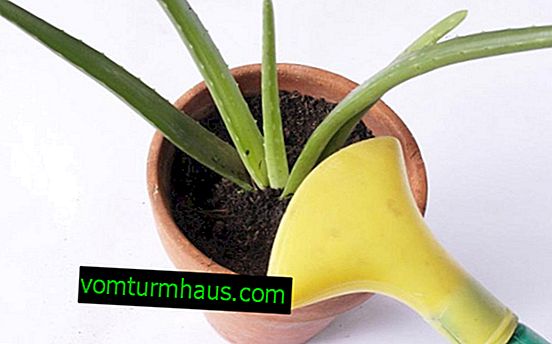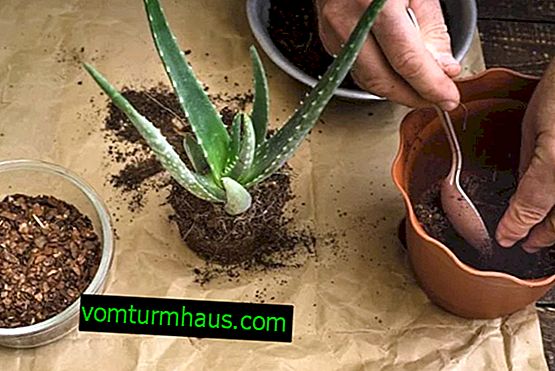How often and how to water aloe at home
Aloe is loved for its aesthetic appearance and valuable healing properties. This succulent is recognized by long fleshy leaves of bright green color with small spikes. In order for the plant to be healthy, beautiful and really useful, it must be properly watered. Watering rules and consider in this article.
Basic rules for growing aloe
Aloe - unpretentious flower, a lot of trouble does not deliver. And yet he needs certain conditions.

These include:
- lighting - the more the better. The most suitable place is the windowsill on the south side. In summer, it is advisable to take them out onto the street or onto the balcony. In winter, it is recommended to find the brightest place in the house for the flower. In the shade, he also takes root well, but the trunk becomes more elongated, and the leaves are paler than usual;
- air temperature should be moderate and appropriate for the season : in the summer - +20 ... + 26 ° С, and in winter - +15 ... + 17 ° С. Many gardeners leave their green pets on the street for the whole summer. Like other succulents, they tolerate differences in day and night temperatures;
- humidity does not matter . Aloe feels great even in a room with dry air and does not need to be moisturized. Spraying is necessary only to wash dust off the leaves;
Did you know? Aloe is an amazingly tenacious flower. If you dig it along with the root, leave it for several weeks, and then plant it again, it will grow further, as if nothing had happened.
- the soil should be loose and light . Special soil for cacti and succulents is perfect. The soil mixture can be prepared independently from turf and leaf soil, humus and sand (2: 1: 1: 1) or from universal soil and coarse sand, for example, vermiculite (4: 1). Be sure to use drainage, which can be expanded clay, pumice or pieces of red brick;
- the pot should fit in size : not very large and not very small. It is necessary to transplant into a container, the diameter and height of which is approximately 2 or 3 cm larger than the previous one. Mandatory conditions for the pot - drainage holes and a deep pan;
- feeding is carried out every 3-4 weeks, starting in April and ending in September. Within a month after transplantation, diseased plants cannot be fertilized;
- Aloe is rarely watered, but abundantly .

How to determine aloe's need for water
In the wild, this plant with juicy leaves grows in Africa, where it is humid only in the rainy season. The flower stubbornly withstands drought and feels great, therefore it is also impossible to fill it often at home.
The best clue that it’s time to water the flower is a dry earth ball. If enough time has passed from the last watering, but the earth is still wet, do not pour water. It is necessary to wait for the complete drying of the soil. The fact that the flower regularly lacks moisture will be visible on dry and thin leaves. We also recommend reading about aloe motley.
What water is better to use
Aloe is very sensitive to the liquid it absorbs. Do not water the flower with tap water. It can contain a lot of chlorine and other harmful substances.
Irrigation water must meet the following criteria:
- quality . You can water only with absolutely clean water. To do this, typing from the tap, it should be defended for at least a day. During this time, chlorine will evaporate, and heavy impurities will settle to the bottom. In winter, you can use thawed snow collected away from roads;
- the temperature changes with the changing season, but always quite warm. In winter, the liquid should be heated so that it is 6–8 degrees higher than room temperature, in spring - up to +20 ... + 22 ° С, and in summer - +30 ... + 35 ° С. If you do not want to warm the water, you can defend it in a warm room for several days. She herself will warm up to room temperature;
- acidity . The aqueous medium should be slightly acidic. To do this, it is advised to add a little citric acid or vinegar (3-5 g per 1 liter) to the water.

Frozen water is best suited for aloe vera irrigation.
It is prepared as follows:
- Pick up tap water and stand for 12-24 hours.
- Drain the liquid, leaving a residue at the bottom, in a plastic bottle.
- Place the bottle in the freezer and leave it there until the liquid completely freezes.
- A container is placed in the room so that the ice melts.
- Wait until the water warms up to room temperature.
Watering Methods
There are two ways to water a succulent : top and bottom. Each of them has its advantages and disadvantages.
- Above, that is, a watering can . Principle: water is poured into the pot from above. The earth is poured, but not the leaves. Pouring until water seeps into the pan. The liquid from the pan should be poured. Advantage: the entire earthen lump is moistened, all roots, especially thick ones, get moisture. Disadvantage: with a small amount of liquid, the lower layers remain dry, and thin roots do not receive water.
Video: How to properly water aloe
- Bottom, that is, into the pallet . Principle: water is poured into the pan if it is deep, or the pot is placed in a deep container with water. After half an hour, the pot is removed, shaking off excess liquid. Advantages: excess moisture remains in the pan, thin roots absorb as much liquid as they need, nutrients are not washed out of the soil. Disadvantage: if the drainage layer is quite high and the roots are thick, they will be left without water.
How to water aloe at home
Aloe will develop in the best way in those conditions that are most similar to natural.
In his homeland, it does not rain often, but plentifully, so the following factors should influence the frequency of watering the succulent in the apartment:
- Season : in warm seasons (spring, summer, in the first half of autumn), water should be watered abundantly no more than once every 2-3 weeks, and in cold seasons even less often - once a month and in moderation. In summer, it is advisable to carry out water procedures in the evening, and in winter in the morning.
- Succulent age : young flowers are in smaller pots, in which the earth dries quickly, so they need more frequent watering (every week). Older plants are less likely to drink, but in large quantities.
- Humidity in the room : the drier the air in the room, the faster the earth dries in the pot and the more often it needs to be watered. If the street is damp (rain or fog), it is better to postpone watering.
- The size of the root system also affects how many times you need to water the flower. The more space the root takes in the pot (especially if it is completely filled), the more often it needs to be moistened.
- Material of which the pot is made (clay, plastic): in clay pottery, the flower needs to be watered more often than in plastic, since clay each time absorbs a certain amount of water.

Features of watering
Proper care during planting and transplanting aloe is of great importance. Water procedures during these periods have their own characteristics.
Watering the shoots
Most often, aloe is propagated by cuttings. Proper soil moisture is necessary for the sprouts to take root and take root.

The landing process is as follows:
- In a cut just cut, the place of cut is sprinkled with coal powder. Then it is left to dry for several days.
- The process is planted in a container of wet sand (previously disinfected) for rooting. It is necessary to water as the sand dries, but very carefully so that the sprouts do not begin to rot.
- When the roots appear (after 1-2 weeks), the shoot is carefully transplanted into a pot with soil for succulents.
- The watering regimen is usual for young plants - 1 time per week.
Watering seeds
Sowing seeds is not so popular.
It is carried out in the following order:
- Pour a special substrate into a previously prepared pot.
- Press seeds lightly into the ground at a distance of at least 2 cm from each other.
- Sprinkle top with disinfected river sand.
- Put the pot in a container with water.
- When the surface of the soil is moistened, the pot is removed from the water and placed in a warm place (+20 ... + 25 ° C).
- Keep the soil moist but not wet.
- After 3 days, the first sprouts should appear.

When transplanting
It is recommended to transplant aloe not earlier than after 3 years. Two weeks before transplanting, watering stops. There are two types of transplantation : with a lump of land (transshipment) and without it.
Transshipment process:
- The plant is pulled out of the pot along with a lump.
- A layer of drainage is poured into a larger pot.
- Insert a lump and add the necessary amount of new earth, slightly compacting it.
- Pour plenty of water.

- The flower is taken out of the pot, carefully freeing the roots from the dry earth.
- In a new pot with drainage, the roots are carefully placed at the bottom, gradually adding prepared substrate and compacting it.
- A layer of earth should be 1 cm below the top edge of the dishes.
- The surface is sprinkled with river sand or expanded clay.
- Watering is possible only 4–5 days after transplantation, when the plant will cope with stress.
The combination of fertilizing and watering
Regular fertilizer strengthens the plant, helps it stay healthy and beautiful. Fertilize aloe with only liquid top dressing. Suitable fertilizer for succulents and cacti.
You need to use them correctly:
- spread fertilizer with water according to the instructions on the package;
- before applying fertilizer, be sure to water the flower with clean water;
- top dressing is watered both in the upper and lower ways, but it is better to pour into the pan to avoid salinization of the soil;
- after transplanting, fertilizing is recommended only after 6 months, and after purchase - after 1 month;
- top dressing should not fall on the leaves so that there is no burn;
- if the flower grows in already fertilized soil, you do not need to water it with fertilizing;
- sick flowers can not be fed;
- You can not fertilize aloe grown for treatment or for cosmetic purposes.

Signs of improper watering
If aloe is regularly watered regularly over time, it will affect its health and appearance.
Signs:
- insufficient watering - the leaves are thin, not juicy, dried;
- excess watering - yellowed and too soft leaves that hang like a rag, and stagnant water in the pot;
- watering with cold water - the leaves suddenly fell.

Useful care tips
Here are some important tips to help you grow a healthy flower:
- the golden rule of watering aloe: better to underfill than to overfill:
- Do not water with cold tap water;
- pour water from pallets;
- It is not recommended to water often in the winter;
- if there are no holes in the pots, they should be done manually.









